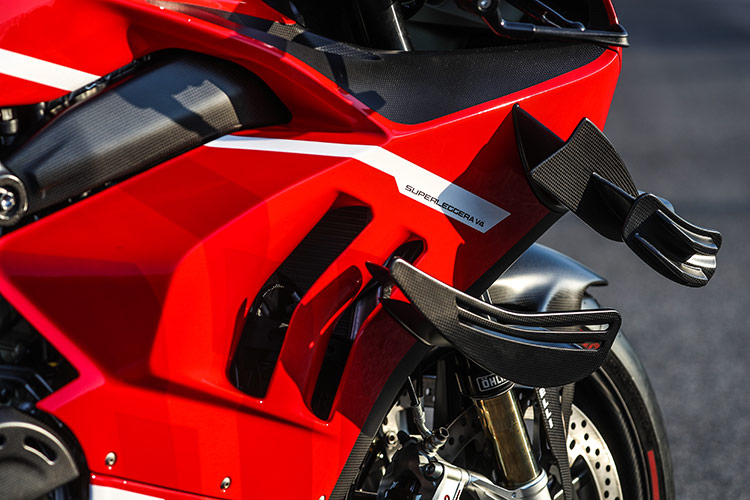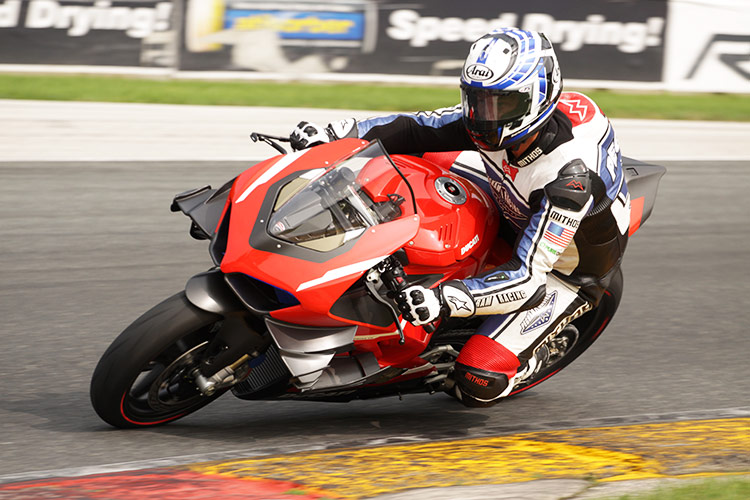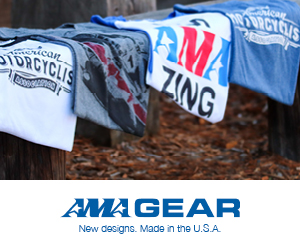Riding Feature
Ducati Superleggera V4 Experience
Larry Pegram Rides The Ultimate Ducati Superbike At Road America
By Matthew Miles
One hundred ninety-six mph.
That is the top speed indicated on the digital speedometer of the Ducati Superleggera V4 moments before Larry Pegram squeezed the front brake le ver, downshifted four times and peeled into Turn 1 at Road America.
“It takes a lot to impress me,” the five-time AMA Superbike race winner said, “but I think that is the best motorcycle I’ve ever ridden. And it’s a street bike.”
Pegram was at the 14-turn, 4.048-mile circuit by invitation of Michael Kiley, owner of Tytlers Cycle, a BMW, Ducati, Indian Motorcycle, Energica and Royal Enfield dealership in Green Bay, Wis., as well as Moto Union in Milwaukee.
“I was the last person to win a Superbike race on a Ducati at Road America,” Pegram said, “so Mike asked if I was available to ride.”
The Motovid.com-organized track day was scheduled for Sept. 14. After notching a pair of Top 10 finishes in the American Flat Track SuperTwins class at the Williams Grove Half-Mile, Pegram flew from Harrisburg, Pa., to Milwaukee.
Tytlers hosted a dinner Sunday night at the Elkhart Lake racetrack, followed by a question-and-answer session.
“They showed the video from 2009 when I beat [seven-time AMA Superbike Champion] Mat Mladin for the win,” Pegram said. “Mat and I were going back and forth every lap. That was pretty neat.”
The next morning, Kiley had a surprise for Pegram—a 2020 Superleggera V4.
Limited to 500 examples worldwide, the carbon-fiber-framed Superleggera V4 is powered by the Desmosedici Stradale R engine, a 16-valve, 998cc, 90-degree V-four that shares its 81 mm bore and 48.4 mm stroke with Ducati’s prototype MotoGP racer.
Ducati says the Superleggera V4 produces a whopping 224 horsepower in street trim. A track-only titanium Akrapovič exhaust bumps that number to 234. Claimed dry weight is 350 pounds, 35 less than a Panigale V4.
“I wasn’t familiar with all of the specs,” Pegram admitted, “but I started looking at the bike, and I thought, ‘Man, this thing is pretty cool.’”
Kiley told Pegram the Ducati was brand new. And that it stickers for $100,000.
“Well,” Pegram asked, “do you not want me to ride it?”
“Oh, no,” Kiley replied. “I want you to ride it.”
“OK,” Pegram said, “because if I’m going to ride it, I’m going to ride it. I’m not going to tool around on it.”
Pegram got even more than he expected.
“I went out for the first session, and it was still a bit cold,” he said. “I only got an out-in lap. But, wow, I knew right away, even with the street tires that it comes with, this thing is a ripper.”
The Superleggera V4 is loaded with pretty much every electronic bell and whistle. With a pro career spanning four decades, Pegram is at ease with the digital side of racing.
“After that one lap,” he said, “we turned everything down a bit, and I went back out.
“I was blown away by how fast it is. And how smooth it is. It feels almost electric. And the engine pulls so far. When it got to around 14,000 rpm, I thought it would be done, but it pulled all the way to redline—15,000 rpm.”
Acceleration is but one of the Superleggera V4’s strong points.
“The biggest thing I noticed is how stable the bike is at high speeds,” Pegram said. “When you come out of the last corner at Road America and head up the hill on any modern-day 1000, even a 600, you have to back off the throttle a little bit. If you kept a Superbike pinned over that hill, it would flip over backward.”
Ducati claims the Superleggera V4’s “biplane” wings generate 110 pounds of downforce at 167 mph.
“This is the first bike I have ridden with wings,” Pegram said. “Over the hill, I could just keep it pinned. I thought wheelie control was keeping the front wheel down, so I turned it off.
“At anything more than 70 or 80 mph, which is pretty much every corner at Road America by the time you get to the exit, the bike wouldn’t lift the front wheel. That was amazing to me.

Photo by Ducati
“The other thing that was great was the engine braking control,” he said. “I could go into Turn 5 as hard as I wanted, and the thing would not step out. It wasn’t pushing me into the corner. It was just doing everything perfectly.”
Toward the end of the day, Pegram went out for one more session.
“I started riding the bike harder and harder,” he said, “and I remember thinking, ‘I better back off. I am getting a little too comfortable with this guy’s $100,000 motorcycle.’”
Pegram said the rear tire was the limiting factor.
“For the amount of power that the bike has, the street-compound tire just wasn’t enough. I told Michael, ‘I think if you put slicks on this thing right now, I could run Top Five in a Superbike race.’ It’s that good of a motorcycle straight off the showroom floor.
“Funny thing is, Michael said, ‘You sold two bikes for me today. Two guys that you blew by came over and committed to putting down deposits.’ That was pretty cool.”
How does the Superleggera V4 compare to the Pegram’s race-winning 1098 R?
“Back in the day,” he said, “I thought the Ducati was more tractable than the inline fours. It was easier to get it hooked up, but it was harder to turn. For me, it was always a Catch-22: The bike wouldn’t turn as well, but it would hook up better.
“At a track like Barber Motorsports Park, where the bike had to turn back on itself, the V-twin didn’t want to do that. At Road America, where it was point and shoot, and I needed to accelerate hard off the corners, the Ducati was really good.
“I always enjoyed riding the Ducatis,” he said. “For me, they always felt more comfortable than the inline fours.”
At 48 years old, Pegram still enjoys riding at a high level.
“I wouldn’t mind doing a couple of road races next year, if there were an opportunity,” he said. “As long as I am fairly competitive, I am going to go out there and have some fun.
“I feel like I can go just as fast, but sometimes my brain and my wrist don’t communicate properly. The mind says, ‘Go!’ and the wrist says, ‘No!’”





